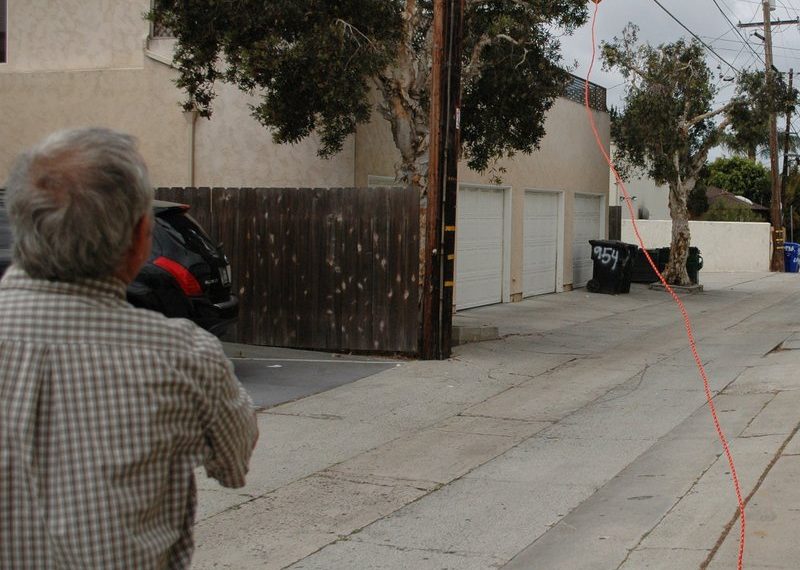
In a small garage workshop in North Pacific Beach, Kenney Pierce, owner of Life 1 Rescue, develops rescue gear designed to quickly and efficiently save lives. His products are used by lifeguards in San Diego, Coronado, Imperial Beach, Encinitas, the Border Patrol Search and the San Diego County Sherriff’s Department. On April 18 at Turquoise Coffee, Pierce kicked off a crowd-funding campaign to help get his newest piece of equipment, the Quick Collar, to the New York Fire Department. Pierce is trying to raise $28,000 to cover production costs, travel expenses and Quick Collar donations. The Quick Collar, designed for swift-water rescue, is already used by the sherriff’s department’s aerial-support units. Pierce hopes to get the Quick Collar on “every fire truck in the world.” Getting a foot in the door at the FDNY is a good way to do that, as it’s one of the few departments with a research and development unit and has a major influence on gear used around the country. Packed in a compact, yellow throw-bag with a durable rope that can be tossed to a victim, the Quick Collar consists of a cinching, auto-inflating floatation tube that secures and protects the victim as he or she is pulled to safety. It can be thrown from riverbanks, helicopters and boats and can mean the difference between life and death in emergencies, Pierce said. Unlike similar water-rescue gear, the Quick Collar is light, compact and comfortable for the victim. Plus, it allows rescuers to stay out of the water, making it much safer for them. As a testament to the design’s durability, one of the first Quick Collars hangs on the wall of Pierce’s workshop. It remains in pristine condition and working order after lifting a 3,000-pound block of concrete during a test run. Pierce’s inspiration for the device came after 10 children drowned during the Guadalupe River flood in Comfort, Texas in 1987. He watched news reports of the incident in horror as children were swept down the river. He believed they could have been saved if the rescuers had access to better equipment. Convinced he could create a piece of equipment that could save more lives, Pierce started working on designs, but struggled at first. “I sat there and physically looked at this thing for months trying to figure out what was wrong with it,” Pierce said. It finally clicked when he saw children’s pool floats being manufactured. He realized by combining a floatation device and a securable strap, drowning victims could be kept above water while efforts are made to safely pull them out. Pierce got a patent for the Quick Collar in 2005 and began marketing it to a number of fire departments. He started working with the FDNY research and development unit, but when the economic recession hit, there was no money in department budgets to test new gear, and trips to New York were too expensive. All progress stopped. Broke and out of options, Pierce took a job managing an apartment complex in Crown Point and worked as a cook. The idea for a crowd-funding campaign came to him after his sister paid for him to go to New York to start working with the FDNY again. Through the crowd-funding campaign, Pierce not only hopes to provide his Quick Collar to the FDNY and eventually rescue teams around the world, but also to educate the public on the need for water-rescue gear. He wants to raise awareness that more lives can be saved with the right equipment. After a stint as a pool lifeguard, Pierce started designing water-rescue gear. He developed a lifeguard rescue belt and a jet-ski towing device. The devices, which are used by lifeguards all around San Diego, including during rescues at La Jolla Cove, allow guards to work safely and quickly. His lifeguard belts incorporate a quick-release, which was developed after lifeguards wanted something that would allow them to easily detach themselves from boats that sink as they try to swim them to safety. “My job is to listen, go talk to them (lifeguards) and listen,” Pierce said. A video, contribution link, donation incentives, description of the Quick Collar and the campaign’s budget can be found at the Quick Collar crowd-funding page at www.indiegogo.com/projects/quick-collar–2.




![newloriware cfo rt upscale new exposure faceai sharpen[1]](https://cdn.sdnews.com/wp-content/uploads/20250513111145/newloriware_cfo_rt-upscale-new-exposure-faceai-sharpen1-360x180.png)








Discussion about this post